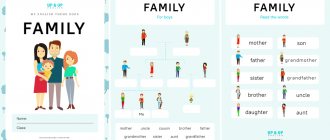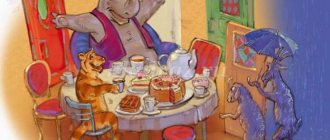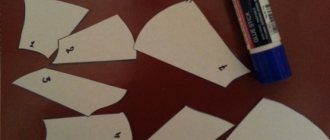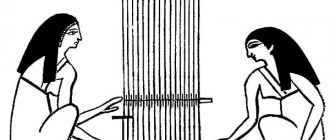MAGAZINE Preschooler.RF
Winner of the All-Russian competition "The most requested article of the month» JANUARY 2018Lesson 1
Unit Phrases Vocabulary Receptive Language Hello! Hello. I'm + (name) Mickey, pencil Say hello to me. Say goodbye to me. Good bye What's your name? This is Mickey. Follow me. Show me (red)
In this lesson, children: 1) say hello and goodbye in English: “Hello!”, “Good-bye!” (“Bye!”) 2) understand by ear the question “What's your name?”; 3) count to five in English; will learn to name colors (red, green, blue, orange and yellow) 4) answer the question “What's your name?”, using the construction “I'm (Dima).” 5) understand “classroom English” (“Good!”, “Good for you!”)
Materials for the lesson: Cards of different colors: red, green, blue, orange and yellow.
The lesson begins with the song: Hello Song (cassette-song 1) page19 (Teacher's Book) The teacher invites everyone to say hello: Say hello to me! Hello Dasha, hello Dima, etc.
Guys, let's get to know each other better! I will ask you What's your name? (What is your name? What is your name?), and you say your name, and that’s how we’ll get to know each other. Just don't forget to say I'm...Dima first.
Color palette memory game.
Let's play in the Memory Game. (Let's play a memory game) Children first name the colors in order after the teacher and try to remember. Then the teacher suggests closing your eyes: So, close your eyes! (close your eyes). And he removes one card - then asks to open it: Open your eyes! (open your eyes) and guess which color is missing. What color is missing? (Which color is missing?) Whoever guesses correctly receives a card with that color.
Listening to a song about the colors red and blue. (chant 4) page 19
Exercise “Colors” Multi-colored butterflies Purpose: to introduce color. The picture shows a meadow. In the meadow you will see several butterflies resting on the hedge. Between every two butterflies, there is one colorless (transparent) one.
Rules of the game:
Between every two butterflies, there is one colorless one. Replace the colorless butterfly with a colored one, whose color is a combination of the colors of the resting butterflies located on either side of the colorless one (for example, a yellow and red butterfly form an orange one) Continue playing until all the colorless butterflies are replaced by flying butterflies
Game of colored cards. (Playtime) Children gather in a circle, the teacher hands them cards and asks them to show a certain color: “Please, show me the red (green/blue) card.” The one who has this card raises it up. The teacher praises the correct display of “Great!” (great) Next, you can exchange cards. Let's change these cards! (Let's exchange cards!) Draw and color.
The teacher asks to sit down at the table: “Please, sit down to the table!” Let's draw" (please sit down at the table! Let's draw." When coloring a picture, you can ask questions: “What color is it? What color is it?
Balloon Game
Welcome to planet Baloons! The teacher names the colors, the children must help catch the right ball. Please, catch me a red balloon! Song Thank you.
End of class
Song “Goodbye Mickey” (chant 3) p.19
Lesson 2
Unit Phrases Vocabulary Receptive Language 1. My family Touch mum. Mum, dad, baby, family, Bambi. Look! This is my family. sister, brother. Yes. No.
In this lesson children will learn:
1) count to five in English; 2) name family members in English; 3) ask a question about a person (Who is it?) 4) understand by ear the expressions “Yes.”, “No.”, “Stand up!”, “Sit down!”, “Hands up!”, “Hands down” !”, “Hands to the sides!”, “Bend left!”, “Bend right!”, “Hop!”. 5) Name the colors.
Materials for the lesson: Cards of family members: mom, dad, brother, sister, baby (Mum, Dad, Brother, Sister, Baby) Cards of different colors: red, green, blue, orange and yellow.
The lesson begins with the song: Hello Song (cassette - song1) Hello, everybody! Good to see you again. Let's begin our English lesson.
The teacher shows the cards and offers to guess the color - asks the question: What color is it? (What color is this?) After the children have fixed the name of the colored cards, we move on to new material. (My Family) You are invited to look at the picture: Please look at the picture. What can you see? (Please look at the picture. What do you see?) Children first name what they see, and then repeat new words after the teacher.
Memory Game.
The teacher once again shows cards with family members and names them one by one. Then he asks the children to close their eyes “Please, close your eyes” / removes the card / “Open your eyes”. Who's missing? (Who is missing?) You can return the card to its place, you can give it to the person who guessed right. (Well done! Excellent!)
Playtime. Well done! Look at me and do the same! Now I will say the words of the English exercises, and you perform the movements.
Hands up! Hands down! Hands on hips! Sit down! Stand up! Hands to the sides! Bend left! Bend right! One, two, three, hop! (When you say these words, you need to jump on one leg.) One, two, three, stop! Stand still!
Listening to Song 5 p. 23
Exercise “Colors” Multi-colored butterflies Purpose: to introduce color. The picture shows a meadow. In the meadow you will see several butterflies resting on the hedge. Between every two butterflies, there is one colorless (transparent) one.
Rules of the game:
Between every two butterflies, there is one colorless one. Replace the colorless butterfly with a colored one, whose color is a combination of the colors of the resting butterflies located on either side of the colorless one (for example, a yellow and red butterfly form an orange one) Continue playing until all the colorless butterflies are replaced by flying butterflies
Let's draw a family.
Blanks with a picture of a family. The teacher first asks to find all family members and show them. Let's find and show Mum on your picture. After the children color and name the colors, ask them to count all family members. Let's count how many people can you see? One – mum, two-dad, three – sister, four – brother, five – baby.
Balloon Game
Welcome to planet Baloons! The teacher names the colors, the children must help catch the right ball. Please, catch me a red balloon! Song Thank you.
End of class
Song “Goodbye Mickey” (chant 3) p.19
Lesson 3
Unit Phrases Vocabulary Receptive Language 1. My family Touch mum. Mum, dad, baby, family, Very Good. Listen and repeat. Touch mum. sister, brother. Yes. No. Let's sing.
In this lesson, children will learn: 1) count to ten in English; 2) name family members in English; 3) assign color names. 4) Learn to perceive commands by ear.
The lesson begins with the song: Hello Song (cassette - song1) Hello, everybody! Good to see you again. Let's begin our English lesson.
The teacher distributes pictures of family members to the children. Children sit in a circle on chairs. The teacher recites the poem at a slow pace.
THIS IS THE FATHER
This is the Father who brings us our …bread. (The child who has a picture of his dad picks up the picture.) This is the Mother who puts us to... bed. (The child who has a picture of his mother picks up the picture.) This is the Brother who plays with his ...ball. (The child who has a picture of his brother picks up the picture.) This is the Sister who plays with her ...doll. (The child who has a sister picks up the picture.) And this is the baby - the smallest of all. (The child who has a baby rings the rattle.)
Playtime “Colors”
We decorate the rug. (choice level 1), where children choose a color themselves - pronounce it in English and paint over any empty cell. After all the cells have been painted over, the teacher names the color in English for each child and invites them to paint the cell. Please, find red/blue/green Now, let's count. How many colors? Children count how many cells they have painted. One-red, two-blue, three-green, etc.
Teams Run! Jump! Swim! Turn around! Hop! Stop! Play in teams with the children, reinforcing each with the appropriate movement. If children do not understand commands, explain their meaning. Children follow commands when signaled by an adult.
Listening to Song 5 p. 23 (repeat)
Game Please show me...
Place pictures of already known family members on the table. Invite the children to the request Please show those and Mum! show a picture with mom, and when asked Please show those and Dad - with dad, etc. Make sure the children have mastered the material well and add new brother and sister cards. Play with new cards and play with a new expression. Invite the children to act as a presenter - to practice the expression Please show those...
Let's draw a family.
Blanks with a picture of a family. The teacher first asks to find all family members and show them. Let's find and show Mum on your picture. After the children have painted all the family members, ask them to repeat the expression This is a family!
Dance game. Welcome to planet dance! Where children will consolidate their knowledge of the Jump, Pull, Push, Dance commands. Song If you are happy.
End of class
Song “Goodbye Mickey” (chant 3) p.19
| Next > |
Magical forest
To develop the English language and increase interest in it, you can play such an exciting game with your baby. Of course, preliminary preparation will be required, but the result is worth it, because in one lesson it is possible to remember and systematize all the knowledge acquired.
First, mom sets up a game situation: “Today we will go on a journey to a magical forest where mysterious living creatures live, they will ask you to complete various tasks. It will be interesting and fun!” Then he plays selected music.
- The first step is to approach the magical forest. Circles painted in various colors familiar to the child are placed on the floor, at a distance of about a step from each other. The baby’s task is to walk along this path, naming the colors. If he gets lost, he will have to start all over again. If a color is stubbornly not remembered, there is no need to torment the child; it is permissible to give a hint. Still, the game should bring joy, not disappointment.
- The second step is to open the door. We walked along the magic path to the entrance to the mysterious forest, now all that remains is to open the door. For fun, mom can prepare a regular lock and key in advance to make the image more visual. But the lock is not just opened with a key, you must first count from 1 to 10 words in English (or name 5 animals, plants, fruits, depending on what you studied with the baby).
- Step three. Meeting the local inhabitants. It turned out that in our magical forest there live amazing animals that look similar to those familiar to us, but are slightly different (illustrations of a green cat, a blue fox, and so on are prepared in advance). You need to greet them using English greetings familiar to the child. To make it fun, mom says that you need to communicate with each of the inhabitants in a special way, for example, with a cat - on one leg, with a fox - standing on your tiptoes. Thus, the child first takes the required position, then greets the animal: Hello, Hi, Good morning.
- Step four. A short story about yourself. The inhabitants of the mysterious forest ask the child to tell something about himself using English. The baby says his name, how old he is, and shares any other information that he is able to voice.
- Step five. Answers on questions. Fairy-tale creatures ask questions or offer to perform some task (for example, list in English everything that the child sees in a red room, or name all the pieces of furniture or transport familiar to him). The main thing is to formulate tasks in such a way that the child has every chance of successfully completing them.
- Step six. Parting. The child again takes the required position (stands on one leg when communicating with the cat, etc.), says Bye, Good bye). After this, his mother gives him a small gift for his efforts, and the game is considered over.
Sweets or toys can be used as a prize. You should not give clothes or something useful - the child will not appreciate it and will be disappointed.
Fun English lessons for children are a great way to prepare them for school and have fun. Using various games and interesting exercises, you can achieve much greater success than with boring cramming. The main rules are to practice regularly, in a good mood, using a variety of game forms.






